Mallorca: Calas, Charming Villages & Barefoot Mornings
- Izabel Stalder

- Jul 27
- 20 min read
Updated: Jul 31

There’s something about Mallorca that sneaks up on you. The first time I visited, years ago with my father, I liked it – the cobbled streets of Palma, the sunny plazas, the hum of Mediterranean life. But it didn’t quite sweep me off my feet.
This June, though, it was different. We spent six days on the island, exploring a completely new route, and it felt like discovering an entirely different Mallorca – wilder, softer, calmer in the mornings and golden in the evenings. Maybe it’s because this time, we focused on its calas – those small, tucked-away coves with water so clear and blue it feels impossible that you’re still in Europe.
Honestly, why fly to the Maldives when this exists a couple of hours away? Sure, we love long-haul trips too, but European summers hit differently – and they hit hard when it comes to crowds. That’s why we usually plan these destinations for late spring or early summer (like this trip), or early autumn when the beaches are quieter, parking is possible, and the sun hasn’t yet reached full power.
Still, even in early June we hit quite a bit of traffic and learned that if you don’t make it to the beaches before mid-morning, you’ll be cosying up to strangers in no time. And oh – the sun? It’s scorching. Bring SPF. Bring a hat. And don’t underestimate that Mediterranean glare.
We planned this route carefully to hit most of the places we dreamed of, but if you want to spend more time in one spot, use our itinerary as inspiration rather than a strict map. Pick what resonates and linger where your heart tells you to stay.
Before I share the details, let’s start with a bit of context.
GENERAL INFORMATION:

Mallorca is the largest of Spain’s Balearic Islands, and its history stretches back thousands of years. The earliest known settlers arrived during the Neolithic period, around 6000 BC, leaving behind megalithic structures and cave dwellings. Later, the Talaiotic culture emerged, building stone towers (talaiots) that still dot the island’s landscape.
The island’s strategic position in the Mediterranean made it a crossroads for many civilizations. The Phoenicians, Greeks, and Carthaginians all traded or settled here at various times. In 123 BC, Mallorca was annexed by the Roman Empire, becoming part of Hispania. The Romans established towns, roads, and agricultural systems that laid the foundation for future prosperity.
After Rome fell, the island faced raids by Vandals and Byzantines. During the Middle Ages, it became a stronghold for Muslim rulers until 1229, when King James I of Aragon conquered Mallorca and incorporated it into the Crown of Aragon. Over time, Mallorca developed its unique culture—a blend of Spanish, Catalan, and Moorish influences—which can still be felt today in its architecture, cuisine, and language.
Today, Mallorca balances its rich history with a reputation as one of Europe’s most beloved holiday destinations.
Location: Mallorca lies in the western Mediterranean Sea, about 170 km (106 mi) off the eastern coast of Spain.
Spain borders: France, Portugal, Andorra, and Gibraltar on the mainland, but Mallorca is part of Spain’s Balearic Islands.
Etymology: “Mallorca” comes from the Latin insula maior (“larger island”), distinguishing it from its smaller neighbour, Menorca.
Size: 3,640 km² (1,405 mi²).
Symbol of Spain: The bull is often seen as Spain’s unofficial symbol.
Symbol of Mallorca: The red and yellow flag of Mallorca includes a castle, representing Palma.
Population: Spain - approx. 48 million; Mallorca- approx. 930,000.
Languages: Spanish and Catalan (Mallorquín is the local dialect of Catalan).
Dictionary:Hi: Hola
Thank you: Gracias
How are you?: ¿Cómo estás?
The bill, please: La cuenta, por favor
Cala - a “cala” is a small cove or inlet, often with calm, clear waters and surrounded by cliffs.
Cap - “cap” means cape or headland, referring to land jutting into the sea.
Currency: Euro (€). For reference: 1 EUR = 1.17 USD.
Local time: Central European Time (CET)
Economy: Tourism dominates, though agriculture (olives, almonds, wine) and maritime industries are also significant.
Best time to visit: May–early June and September–October. I prefer traveling just before or after peak season to avoid heavy traffic and crowded beaches.
What to pack: Sunscreen, insect repellent, hats, sunglasses, reusable water bottles, good walking shoes for rocky paths, light clothing, and a beach bag.
Electricity plug: For Mallorca's electricity, use Type F plugs (two round pins with side grounding clips) at 230V, matching mainland Europe's standard. Plugs from most European countries (like Type C or E) will work directly, but travellers from the UK, US, Canada, or Australia will need a Type F adapter. Always check if your devices support 230V to avoid damage, as 110V appliances require a voltage converter. Safe travels!
Food culture in Mallorca: A blend of Mediterranean and Catalan flavours, heavily influenced by the sea and local produce.
Staple ingredients: Olive oil, almonds, citrus, sobrasada (spicy sausage), fresh seafood, tomatoes, rosemary.
Typical foods:
Pa amb oli: rustic bread with olive oil and tomato
Tumbet: vegetable casserole
Ensaimada: spiral pastry
Arroz brut: spiced rice stew
Travel requirements: Mallorca is part of Spain’s Schengen zone. Most EU and US visitors don’t need a visa for short stays.

HOW TO GET AROUND:
We rented a Mini Cooper from Gobycar and loved the flexibility. Public buses connect major towns, and many visitors also rent bicycles or scooters. The island is very popular with cyclists.
DAY-BY-DAY ITINERARY
Mallorca is one of those places that seduces you slowly. At first, it feels familiar: turquoise coves, winding roads, charming old towns. But then, moment by moment, it reveals something deeper — and by the end, you realize it’s quietly stolen your heart.
Here’s how we spent 6 days exploring this Balearic beauty.
DAY 1.
After a long delay and a late-afternoon flight, we finally touched down in Mallorca at 7 pm. The warm Mediterranean air welcomed us as we made our way to Gobycar, where a little shuttle van whisked us off to pick up our rental car.
PALMA AIRPORT - GOBYCAR – approx. 5 km
From there, we drove straight to our first dinner spot. We’d reserved a table a month in advance, and there was no way we were going to miss it.
GOBYCAR - SEA CLUB CAP ROCAT – approx. 15 km
SEA CLUB CAP ROCAT
Dinner that evening was at Sea Club Cap Rocat, perched dramatically on the edge of an old fortress overlooking the Balearic Sea. Upon arrival, we were greeted and taken down to the restaurant in a golf cart — a small detail that felt strangely cinematic, like entering a secret world.
Here, time seemed to slow down and soften. The cliffside terrace offered a front-row seat to one of the most mesmerizing sunsets we’ve ever witnessed, with the sky melting from fiery orange to the softest blush pink and finally into twilight blue. The only soundtrack was the rhythmic crash of waves below and the gentle clinking of glasses.
The setting, service, and food blended seamlessly into an evening that felt both indulgent and effortless. As the air cooled and candles flickered to life around us, it felt like we were wrapped in a private little world — one that stayed with us long after we left. This wasn’t just dinner; it was a memory we’ll carry for years.
CAP ROCAT - COLÒNIA DE SAND JORDI - approx. 44 km
After dinner, we drove southeast to Colònia de Sant Jordi, where we stayed at Universal Hotel Romántica for the night. While the hotel wasn’t quite our style, it was perfect for what we needed — a budget-friendly, convenient base for an early start the next morning.
DAY 2.
We woke up early, ready to explore Mallorca’s southeast coast. The sunrise light over Colònia de Sant Jordi hinted at the kind of day ahead — full of vivid colours, winding roads, and little slices of paradise waiting to be discovered.
UNIVERSAL HOTEL ROMÁNTICA - PARC NATURAL ES TRENC – approx. 6 km
PARC NATURAL ES TRENC
Our first stop was Parc Natural Es Trenc, a protected area famous for its salt flats and birdlife. On the way in, we were greeted by flamingos — elegant adults wading gracefully alongside their fluffy grey chicks, a reminder of how rich this ecosystem is.
The salt pans here have been in use since Roman times, and you can see vast white mounds of harvested sea salt sparkling under the Mallorcan sun. The air feels different here — still, almost meditative, carrying a mix of salty breeze and the sound of distant birds. Parking costs €8, and it’s worth it not only for access to the natural park but also to visit Playa Es Trenc, one of the island’s longest and most unspoiled beaches. The water here is an unreal shade of turquoise, and the sand stretches endlessly.
PARC NATURAL ES TRENC - CALA LLOMBARDS - approx. 16 km
CALA LLOMBARDS
By mid-morning, we arrived at Cala Llombards, one of our favourite calas on the island. The drive through narrow village streets and pine forests felt like an adventure in itself. Thankfully, we snagged a spot in the tiny parking lot directly next to the beach — by the time we left, cars were circling like sharks, and chaos had set in.
Tucked into Mallorca’s rugged coastline, Cala Llombards is the definition of Mediterranean charm. Crystal-clear water laps at soft white sand, framed by limestone cliffs and scattered pine trees. Old fishermen’s boathouses dot the edges of the cove, their weathered doors adding character to the already postcard-perfect scene. We spent a blissful hour swimming and lounging here, feeling like we’d stumbled onto a secret… though in summer, it’s far from unknown.
CALA LLOMBARDS - CALA S’ALMUNIA - approx. 1.7 km
CALA S'ALMUNIA
Our next stop was Cala s’Almunia. When we arrived, all the closer parking was already taken, and the narrow road leading down had been closed off by police. We left the car in a larger lot near the bus stop and walked down through the quiet residential neighbourhood.
The descent itself is part of the experience: a narrow path winds past rocky cliffs, wildflowers, and glimpses of the sea far below. Cala s’Almunia is more rugged than Llombards, but it has a raw, untamed beauty. This little cove is a favourite among cliff jumpers — we watched a few brave souls leaping off rock ledges into the deep blue water, their laughter echoing off the stone walls.
CALA S’ALMUNIA - CALÓ DES MORO - walking distance, 5–10 min
CALÓ DES MORO
Just a short walk further is Caló des Moro, Mallorca’s Instagram-famous jewel. And yes, the photos don’t lie — it really is breathtaking, with white sand and water so clear it seems lit from within. But the crowds? They’re real too. Even in the beginning of June, there was already a queue forming at the steep descent to the beach.
Good to know:
The path is rocky and uneven — wear decent shoes, not flip-flops.
Bring plenty of water and snacks; there are no facilities here.
Go early (before 9 AM) if you want a chance to enjoy it before the masses arrive.
CALÓ DES MORO - CALA SANTANYÍ - approx. 10 km

CALA SANTANYÍ
After climbing back up from Caló des Moro, we drove to Cala Santanyí, hoping for a relaxing lunch. Unfortunately, every beachfront table was booked solid for the week. The cove itself is lovely — wider and more developed than the previous ones, with soft sand and calm water ideal for families. But after seeing the earlier calas, we were craving something quieter.
CALA SANTANYÍ - PORT DE CALA FIGUERA - approx. 4.1 km
PORT DE CALA FIGUERA
Instead, we headed to the Port of Cala Figuera, one of the most picturesque fishing harbours on the island. This little port is like stepping into an old postcard — a narrow inlet where emerald-green water slips quietly between rows of traditional llaüts (Mallorcan fishing boats). The air smelled faintly of salt and fresh fish as we strolled along the quay, passing nets drying in the sun and fishermen chatting by their boathouses.
The pastel-coloured houses lining the water, with their green shutters and stone steps leading straight into the sea, give Cala Figuera its charm. Time seems to slow down here. There’s no beach, no crowds — just a peaceful little community built around the rhythm of the tides. It felt like the perfect antidote to the busy coves earlier in the day.
PORT DE CALA FIGUERA - SANTANYÍ TOWN - approx. 5.8 km
SANTANYÍ TOWN
Our next stop was Santanyí, a charming town filled with ochre-coloured stone buildings and lively squares. We strolled through cobbled streets lined with boutiques, art galleries, and cafes, soaking up the laid-back atmosphere. Lunch here felt like a reset before the final stretch of our day.
SANTANYÍ - CALA PI - approx. 38 km

CALA PI
In the late afternoon, we made our way to Cala Pi, a narrow inlet with dazzling water framed by cliffs on both sides. Once famous on Instagram for a dramatic rock outcrop used as a photo spot, we learned that the rock actually broke off recently and most probably fell into the sea. The area is now fenced off for safety — a sobering reminder that nature isn’t a prop.
CALA PI - PAGUERA - approx. 67 km
As the sun began to dip, we drove west to Paguera, checking into BQ Paguera Boutique Hotel. The hotel was simple but perfect for what we needed: a clean, comfortable base to sleep before another full day of exploring.
Dinner that night was something special.
PAGUERA - RESTAURANTE ILLETA, CAMP DE MAR - approx. 3 km
RESTAURANTE ILLETA
Connected to the shore by a narrow wooden bridge, Restaurante Illeta sits on a rock in the middle of the sea. Crossing over felt like stepping into a dream — the sound of waves lapping beneath us, the soft glow of lanterns, and the warm evening air wrapping around us like silk.
The sunset here was nothing short of cinematic. I had two vegan options on the menu — the artichoke dish was divine, though the cauliflower wasn’t quite for me. But honestly, it didn’t matter. This place isn’t just about food; it’s about the entire sensory experience. Make sure you book a month in advance; it’s worth every bit of effort.
CAMP DE MAR - MAGALUF - approx. 14 km
MAGALUF
After dinner, we decided to check out Magaluf, curious to see what the island’s notorious party hub was like. It was lively, chaotic, and very much not our scene. On top of that, I suddenly felt sick — I suspect someone swapped my coconut milk for regular milk earlier in the day. Being vegan, my stomach didn’t handle it well, and I ended up having to leave early.
We returned to the hotel exhausted, already dreaming of tomorrow’s adventures.
DAY 3.
We left our little base in Paguera early in the morning, ready for a day of winding roads, mountain air, and some of Mallorca’s prettiest villages.
PAGUERA - VALLDEMOSSA - approx. 42 km
VALLDEMOSSA
Tucked into the heart of the Tramuntana mountains, Valldemossa feels like stepping into another time entirely. With cobblestone streets lined with stone houses and green shutters, every corner looks like it’s been painted by hand. Bougainvillea cascades over balconies, and little cafés spill out onto the quiet squares.
This charming village is famous for its connection to composer Frédéric Chopin and writer George Sand, who spent a winter here in the 1830s. You can still visit the Royal Charterhouse, where they stayed, and wander the peaceful cloisters scented with lavender and cypress.
Tip: Try a “coca de patata,” the soft, sweet Mallorcan potato pastry dusted with powdered sugar. Best enjoyed warm with an almond milk café con leche.
VALLDEMOSSA - FORNALUTX - approx. 28 km
FORNALUTX
Our next stop was Fornalutx, often called “the prettiest village in Spain” — and we’d say it lives up to the title. This small mountain village is less visited than Valldemossa but just as charming, with narrow stone streets and orange trees peeking over walls.
Fornalutx feels intimate, almost secret. The plaza at its heart is the perfect place to pause with a fresh orange juice (squeezed from Sóller valley oranges) and watch the slow pace of village life.
FORNALUTX - SÓLLER - approx. 4.7 km
SÓLLER
From Fornalutx, it was a short but dramatic drive down to Sóller, navigating narrow roads and hairpin bends. Parking can be tricky here, but we managed to find a spot near our hotel — and what a hotel it was.

WHERE TO STAY
ECOCIRER HEALTHY STAY
We stayed at Ecocirer Healthy Stay, a beautiful boutique hotel in the centre of town with a big heart for sustainability. Each room has its own name and unique design, and the vegetarian breakfast is the kind that makes you want to linger all morning: fresh fruit, homemade bread, vibrant smoothie bowls. There’s even a little pool corner to cool off after exploring.
Instagram: @ecocirer
SÓLLER
Sóller itself is a delight to wander. At the heart of town is Plaça Constitució, where cafés buzz beneath the grand modernist façade of Sant Bartomeu Church. Designed in part by a student of Antoni Gaudí, the church’s intricate stonework and striking rose window bring a splash of Catalan modernism to this mountain town.
From here, the charming wooden tram to Port de Sóller clatters past orange and lemon groves every 30 minutes or so — a lovely way to see the valley in slow motion.
If you have time, the vintage train from Palma to Sóller (the “Ferrocarril de Sóller”) is also iconic, with original wooden carriages and incredible mountain views.
SÓLLER - DEIÀ - approx. 11 km
DEIÀ
In the evening, we made our way to Deià, one of Mallorca’s most poetic villages. It’s tiny, set into terraced olive groves overlooking the sea, with golden stone houses glowing in the late afternoon sun. This village has long been a magnet for artists, writers, and dreamers — and you feel that creative energy in the air.
RESTAURANTE MIRÓ, BELMOND LA RESIDENCIA
We wandered the narrow lanes before heading to dinner at Restaurante Miró, tucked within the legendary Belmond La Residencia.
Where the sun and the moon meet over stone rooftops and terraced olive groves.
From the terrace, we watched the day melt into night, the mountains turning indigo as the first stars appeared. This isn’t just dinner; it’s the kind of experience that stays with you — where the view, the light, and the moment come together perfectly.
DEIÀ - SÓLLER - approx. 11 km
Afterwards, we drove back to Sóller under a velvet sky and fell asleep with the scent of orange blossoms still in the air.
DAY 4.
SÓLLER - PORT DE SÓLLER - approx. 6 km
PORT DE SÓLLER
We started the morning with a quiet drive down from the hills into Port de Sóller, the elegant sister to the inland town. Once an isolated fishing village, the port has transformed into a chic, laid-back destination that still manages to keep its soul intact.
The promenade curves around the horseshoe bay, lined with palm trees, cafés, and moored sailboats bobbing gently in the water. The old wooden tram still rolls its way down from the main town, stopping right at the port’s edge — an echo of the past that brings a nostalgic charm to the shoreline.
Port de Sóller is one of the few natural harbours on the west coast of Mallorca, which made it an important trade and fishing hub in centuries past. Now, it’s more about sun-drenched afternoons, fresh seafood, and views that stretch endlessly toward the horizon.
PORT DE SÓLLER - CALA DEIÀ - approx. 15 km

CALA DEIÀ
From the port, we continued along the winding coastal road toward Cala Deià, one of Mallorca’s most iconic little coves. This is not your wide, sandy beach kind of stop — Cala Deià is small, rocky, and utterly stunning, tucked between steep cliffs and olive trees.
Though it’s not the most comfortable spot to lay down a towel, the water is crystal-clear and rich in colour, turning shades of emerald and blue depending on the time of day. The real experience here is about the atmosphere — peaceful, raw, and timeless.
CA'S PATRÓ MARCH
After a refreshing swim, we climbed the stone steps to Ca’s Patró March, perched right on the cliffside above the water. It’s one of the most sought-after restaurants on the island, and for good reason — not only for the location, but for the food and service. While the menu is mainly focused on seafood, the staff made every effort to create something special for me as a vegan. It was thoughtful, memorable, and full of flavour — a perfect example of Mediterranean hospitality done right.
CALA DEIÀ - MIRADOR ES COLOMER - approx. 84 km
MIRADOR ES COLOMER
After lunch, we crossed the island toward the wild northern coast. Our next stop was Mirador es Colomer, one of the most striking viewpoints in Mallorca. Located on the Formentor Peninsula, it offers a dramatic panorama over steep cliffs plunging into the sea, with Cap de Formentor stretching out in the distance like a sleeping dragon.
The viewing platform is perched over a cliff edge, and from here you can see the full spectrum of the northern coastline — rugged, isolated, and astonishingly blue. It’s also not unusual to see goats climbing the rocky hills or standing fearlessly on narrow ledges.
This is one of the best sunrise spots on the island — and we’d return again the next morning to experience it in a completely different light.
MIRADOR ES COLOMER - FOUR SEASONS MALLORCA AT FORMENTOR - approx. 4.6 km
From the viewpoint, it was a short drive deeper into the Formentor Peninsula, but this is a protected area — access is regulated, and you’ll need a permit if you’re driving beyond the checkpoint. Ours was arranged by the hotel in advance, which made the entry smooth.
WHERE TO STAY

FOUR SEASONS MALLORCA AT FORMENTOR
Tucked away on a private stretch of Mallorca’s northern coast, Four Seasons Mallorca at Formentor is the kind of place that changes your pace the moment you arrive. Surrounded by pine forest and overlooking the turquoise curve of Formentor Bay, it’s a retreat where design, nature, and service align to create something quietly extraordinary.
We were hosted for the first night in the Grand Sea-View Suite, where the windows opened straight onto the Mediterranean — the sea so close it almost felt like you could reach out and touch it. Morning light poured in gently, the breeze carried the scent of pine, and the silence was only broken by birdsong.
Later in our stay, we moved to the Grand Pine-View Suite, complete with a private plunge pool tucked into the forest canopy. The atmosphere here is totally different — still luxurious, but with a deep sense of calm and privacy. It felt like a secret hideaway carved out of the mountains.
The spa is a standout — elegant, contemporary, and entirely focused on wellness. Whether it’s a deep tissue massage after a long travel day, or just a few hours in the thermal circuit, it invites you to reset completely.
The hotel has multiple restaurants, each designed with a sense of place. On our first night, we had dinner at Shima, their contemporary Nikkei restaurant. It’s one of those rare combinations of subtlety and boldness — elegant flavours, artful plating, and a view that steals your attention between every course. The vegan dishes I was served were thoughtful and refined, with fresh ingredients that let the textures and seasoning speak for themselves.
Service throughout the stay was warm, professional, and intuitive. The staff seemed to anticipate what you needed before you even asked — and whether it was a beach towel, special dietary request, or just a quiet conversation at the bar, everything was handled with understated grace.
This isn’t a place that shouts luxury. It whispers it — in the stillness of the forest, the weight of the sheets, the rhythm of the waves.
Instagram: @fsrmallorca
Book here: Four Seasons Resort Mallorca at Formentor
DAY 5.
FOUR SEASONS MALLORCA AT FORMENTOR
Sometimes the most memorable days are the ones where very little happens — where you allow yourself to slow down, be still, and take it all in. This was one of those days.
We stayed close to the hotel, letting the landscape and stillness of Four Seasons Mallorca at Formentor shape the rhythm of our hours.
After breakfast, we started the morning with a couples massage at the spa — easily one of the highlights of our wellness experiences. Set within a tranquil wing of the hotel surrounded by pine trees, the spa offers that rare combination of sensory calm and skilled therapists. Everything, from the temperature of the room to the natural scent of oils, was attuned to relaxation.
Afterwards, we drifted slowly toward Quiosc, the relaxed poolside restaurant that manages to feel both laid-back and refined. The setting is exactly what you dream of when you think of summer in the Mediterranean — umbrellas swaying in the breeze, a long lunch stretching into the early afternoon, and food that’s light, fresh, and generous.
That afternoon, we changed rooms to the Grand Pine-View Suite, a space that felt like a hidden refuge among the trees. The private plunge pool was tucked beneath a canopy of forest, where the only sounds were birds and the breeze. From this suite, the sea was still visible, carried on the wind and reflected in the light.
MIRADOR ES COLOMER
In the early evening, we couldn’t resist heading back out for a short mission — sunset at Mirador es Colomer. We’d seen it during the day, but sunset transforms this place. The cliffs catch fire in the golden light, and the shadows stretch out slowly over the water. It’s one of those rare spots that feels cinematic — as if nature is performing just for you.
back to the hotel...
We returned to the hotel just in time for dinner at Mel, the hotel’s elegant Mediterranean restaurant. As always, the service was effortless. The menu blends traditional Spanish ingredients with a modern sensibility — and again, the team was incredibly thoughtful in adapting everything to my vegan preferences without compromising on flavour or creativity.
It was the kind of evening that slips by quietly but leaves a strong impression — soft conversations, warm air, good wine (or in my case, herbal tea), and the sense that there’s nowhere else in the world you need to be.
DAY 6.
FOUR SEASONS MALLORCA AT FORMENTOR
We began our morning slowly — breakfast in the room, laid out beautifully beside our private plunge pool, with sunlight flickering through the pines. There’s something deeply calming about having the sea in the distance, the quiet of the forest around you, and no one else in sight. After breakfast, we took a short walk down to the beach in front of the hotel — calm, clear, almost mirror-like in the morning light. It’s the kind of beach you dream about and then don’t want to share with anyone once you find it.
FOUR SEASONS MALLORCA AT CAP FORMENTOR – CAP FORMENTOR - approx. 8 km
CAP FORMENTOR
After soaking in the serenity, we decided to drive up to the famous Cap de Formentor, expecting a smooth ride since we had received a driving permit. The barrier opened, and the security team near the entrance reassured us that if it lifts, we’re good to go.
Well — we won’t say exactly what happened next, but let’s just say we learned the hard way that access to Cap Formentor is extremely restricted. What we recommend: leave your car at the hotel and go by shuttle, public bus, walk, or bike.
The road is narrow, winding, and carved right into the cliffs — absolutely stunning, with panoramic views over the sea and forest. If you’re on foot or by bike, it’s about an 8–10 km journey each way depending on your starting point, and definitely worth it if you’re up for a challenge. There are regular public buses during the high season from Formentor beach to the lighthouse and back. Best advice: go early, and enjoy the ride — this is one of the most scenic routes in Mallorca.
CAP FORMENTOR – SA CALOBRA - approx. 63 km
COLL DELS REIS / MA-2141
After regrouping and laughing off the mishap, we headed out on one of Mallorca’s most legendary drives: the road to Sa Calobra, officially MA-2141. This is not your average coastal drive — it’s a masterpiece of civil engineering. With hairpin turns, steep cliffs, and breathtaking views at every corner, the road itself is as much the destination as Sa Calobra is.
It takes about an hour and a half from Formentor, but every second is memorable — a rollercoaster carved into the side of the Tramuntana mountains, with switchbacks that feel like they’re suspended in the air.
SA CALOBRA
And then you arrive at Sa Calobra, where towering cliffs rise dramatically above an aquamarine cove, and the sea seems impossibly still in contrast to the wild terrain. From the parking lot, there’s a short and scenic walk — through tunnels carved right into the rock, leading to the Torrent de Pareis canyon. The whole place feels cinematic, a secret carved out of stone and water.
Even in June, it gets busy — so come early if you want to catch the stillness before the crowds settle in. There’s a kind of magic here that’s hard to describe — part natural wonder, part spiritual silence.
SA CALOBRA – DEÍA - approx. 45 km
In the evening, we made our way back through the mountains and coast to Deía, a place that had already given us some of our favourite memories on the island. Tonight, it gave us one more.
ES PI RESTAURANT
Dinner at Es Pi wasn’t just a meal — it was a moment. Tucked into the quiet folds of this terraced village, surrounded by pine and stone, Chef Marcel Ress (yes, of Top Chef fame) created a series of dishes that were as beautiful as they were thoughtful. They were kind, accommodating, and genuinely warm — making sure even as a vegan I felt part of the full experience.
We lingered at the table, not wanting it to end. The evening air was soft, carrying that signature Deía scent of pines, salt, and something ancient. Lanterns glowed softly, casting golden light over olive wood tables and long conversations.
It felt like the right way to close this chapter of our trip — with presence, with gratitude, with beauty.
DEÍA – ALUA LEO (NEAR PALMA AIRPORT) - approx. 36 km
After dinner, we drove to Alua Leo, a simple hotel not far from the airport. It wasn’t luxurious, but it was clean and convenient for our early flight the next morning — and after a long and full day, that was all we needed.
DAY 7.
Adéu, Mallorca!
As our plane climbed into the pink-gold dawn, the island’s mountains glowed below like embers. We whispered "adéu" — not "goodbye," but "fins aviat" (see you soon). This trip was a love story written in second chances that bloomed into a love affair: from the electric-turquoise calas and cliffside dinners to the warmth of its people, Mallorca proved utterly spellbinding. Yes, June’s lively pulse means crowds, but every hidden cove, every bite of pa amb oli, every "bon dia" was worth it. This island isn’t just beautiful—it’s alive. Until next time, gràcies for the magic, the light, and the reminder that some loves only deepen with time.
































































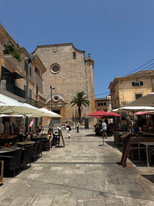

























































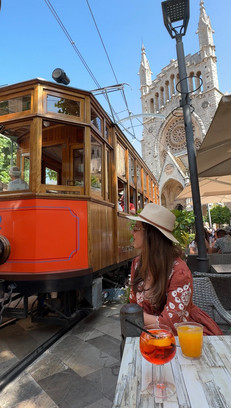



























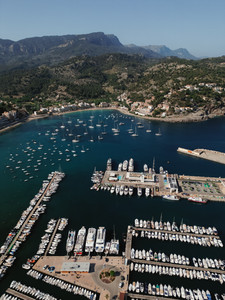



















































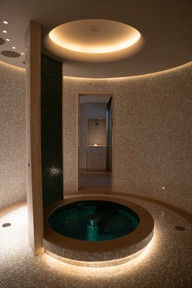











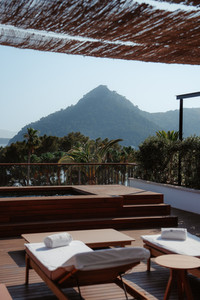



























































Comments